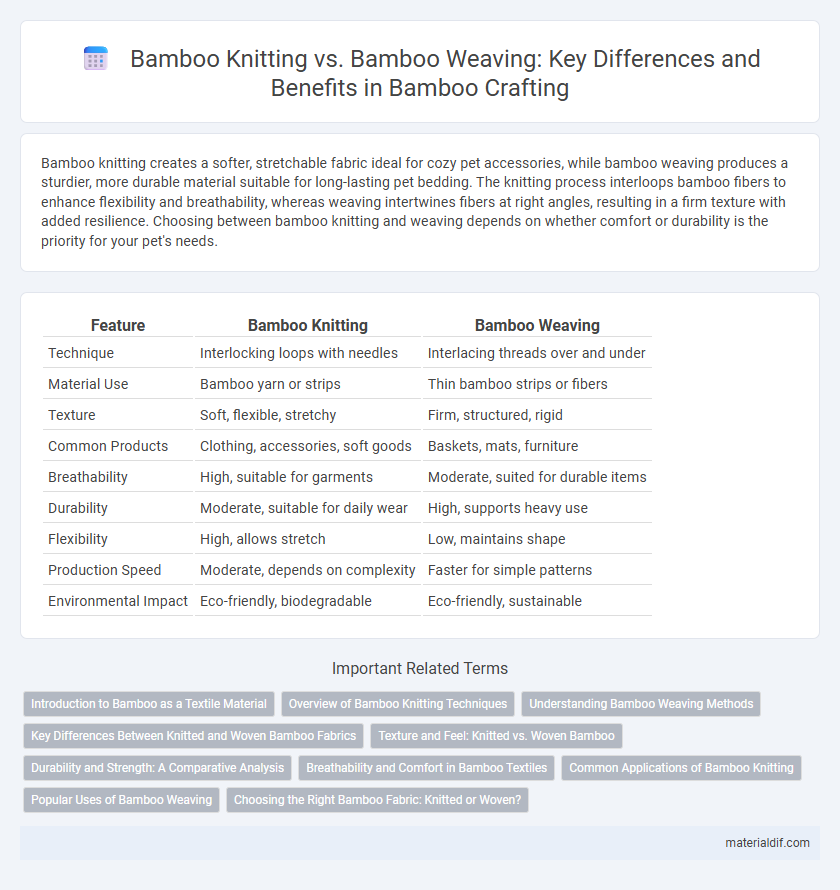Bamboo knitting creates a softer, stretchable fabric ideal for cozy pet accessories, while bamboo weaving produces a sturdier, more durable material suitable for long-lasting pet bedding. The knitting process interloops bamboo fibers to enhance flexibility and breathability, whereas weaving intertwines fibers at right angles, resulting in a firm texture with added resilience. Choosing between bamboo knitting and weaving depends on whether comfort or durability is the priority for your pet's needs.
Table of Comparison
| Feature | Bamboo Knitting | Bamboo Weaving |
|---|---|---|
| Technique | Interlocking loops with needles | Interlacing threads over and under |
| Material Use | Bamboo yarn or strips | Thin bamboo strips or fibers |
| Texture | Soft, flexible, stretchy | Firm, structured, rigid |
| Common Products | Clothing, accessories, soft goods | Baskets, mats, furniture |
| Breathability | High, suitable for garments | Moderate, suited for durable items |
| Durability | Moderate, suitable for daily wear | High, supports heavy use |
| Flexibility | High, allows stretch | Low, maintains shape |
| Production Speed | Moderate, depends on complexity | Faster for simple patterns |
| Environmental Impact | Eco-friendly, biodegradable | Eco-friendly, sustainable |
Introduction to Bamboo as a Textile Material
Bamboo as a textile material offers exceptional sustainability and softness, making it ideal for both knitting and weaving. Bamboo fibers in knitting create lightweight, breathable fabrics with excellent elasticity, while in weaving they produce durable, smooth textiles with a distinct sheen. The natural antibacterial properties and moisture-wicking ability of bamboo fibers enhance comfort and functionality across both techniques.
Overview of Bamboo Knitting Techniques
Bamboo knitting techniques utilize soft, flexible bamboo yarns that provide natural antibacterial properties and excellent moisture-wicking capabilities. The process involves looping and interlocking bamboo fibers with knitting needles, creating lightweight, breathable fabrics ideal for garments and accessories. This method contrasts with bamboo weaving, which interlaces fibers in a crisscross pattern to produce stronger, more rigid textiles commonly used in home furnishings.
Understanding Bamboo Weaving Methods
Bamboo weaving involves interlacing flexible bamboo strips to create intricate patterns and sturdy structures used in baskets, mats, and furniture. Unlike bamboo knitting, which uses yarn made from bamboo fibers and involves looping stitches, weaving relies on the crisscrossing of rigid bamboo strands to form durable and decorative items. Understanding the techniques of bamboo weaving highlights its cultural significance and versatility in producing environmentally sustainable crafts.
Key Differences Between Knitted and Woven Bamboo Fabrics
Knitted bamboo fabric features interlocking loops, offering greater stretch, breathability, and softness ideal for activewear and intimate apparel, while woven bamboo fabric is created by interlacing yarns at right angles, resulting in a sturdier, more structured material suitable for upholstery and outerwear. Knitting allows for more flexibility and moisture absorption, enhancing comfort in casual clothing, whereas weaving provides durability and resistance to wear, making it preferable for heavy-duty textile applications. The production techniques impact fabric texture, weight, and performance, which determine the optimal use case for bamboo textiles in fashion and home furnishings.
Texture and Feel: Knitted vs. Woven Bamboo
Knitted bamboo fabric offers a soft, stretchy texture that drapes smoothly over the body, providing a comfortable and breathable feel ideal for casual and active wear. In contrast, woven bamboo fabric has a tighter structure with enhanced durability and a crisp texture, making it suitable for formal garments and home textiles. The distinct construction methods result in knitted bamboo being more flexible and plush, while woven bamboo provides a firmer, more structured touch.
Durability and Strength: A Comparative Analysis
Bamboo weaving typically offers greater durability and strength compared to bamboo knitting due to its interlaced structural pattern that enhances load-bearing capacity. Woven bamboo fibers tightly bind together, resulting in products resistant to wear, tear, and deformation, ideal for furniture and flooring applications. In contrast, knitted bamboo, with its looped construction, provides flexibility and softness but generally exhibits lower tensile strength and durability under heavy stress.
Breathability and Comfort in Bamboo Textiles
Bamboo knitting enhances breathability by creating a porous fabric structure that allows air to circulate freely, promoting natural moisture-wicking and quick drying for superior comfort. Bamboo woven textiles, while denser, offer durability and a smooth texture but may provide slightly less ventilation compared to knitting. The inherent thermo-regulating properties of bamboo fibers ensure both knitted and woven fabrics maintain comfort by keeping the skin cool and dry in warm conditions and warm in cooler environments.
Common Applications of Bamboo Knitting
Bamboo knitting is commonly applied in creating soft, breathable fabrics ideal for apparel such as socks, baby clothes, and activewear due to bamboo's moisture-wicking properties. Compared to bamboo weaving, which produces more rigid and structured textiles for home decor and upholstery, bamboo knitting offers flexibility and comfort for garments worn close to the skin. The antimicrobial and hypoallergenic qualities of bamboo fibers further enhance the suitability of bamboo knitting for sensitive skin products.
Popular Uses of Bamboo Weaving
Bamboo weaving is widely popular for creating durable and aesthetically pleasing products such as baskets, mats, and furniture, prized for their natural flexibility and strength. Unlike bamboo knitting, which is less common and typically used for lightweight items or artistic crafts, bamboo weaving leverages traditional techniques to produce functional household goods and decorative pieces. The intricate interlacing of bamboo strips in weaving enhances the material's longevity and resistance to wear, making it a preferred method in sustainable and eco-friendly manufacturing.
Choosing the Right Bamboo Fabric: Knitted or Woven?
Bamboo knitting produces a soft, stretchy fabric ideal for activewear and close-fitting garments, while bamboo weaving creates a durable, structured fabric suited for home textiles and outerwear. Knitted bamboo fabric offers excellent breathability and moisture-wicking properties, making it perfect for comfort-focused clothing. Woven bamboo fabric, on the other hand, provides enhanced strength and wrinkle resistance, supporting longevity and shape retention in products.
Bamboo knitting vs Bamboo weaving Infographic

 materialdif.com
materialdif.com